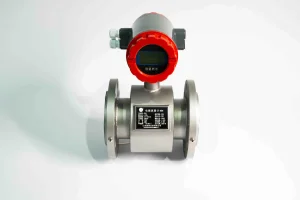
Точное измерение потока имеет большое значение на заводах и заводах. Это помогает улучшить процессы, экономить энергию и соблюдать правила. Например, при добавлении химических веществ в очистку воды или перемещении шламы в горнодобывающей промышленности точный поток обеспечивает использование правильного количества материала. Это уменьшает количество отходов и поддерживает качество продукции. Протокометры действуют как глаза системы. Без них вы просто догадываетесь.

Две популярные технологии - магнитные расходомеры и массовые расходомеры. Магнитные расходомеры, также называемые электромагнитными расходомерами, измеряют объем проводящих жидкостей с помощью магнитных полей. Они хорошо работают для твердых жидкостей, таких как сточные воды или шламы. Между тем, массометры потока Кориолиса измеряют массу напрямую. Они идеально подходят для точных работ, таких как производство лекарств или распределение газа.
Магнитный расходомер’ Принцип работы основывается на законе Фарадея об электромагнитной индукции. Когда проводящая жидкость перемещается через трубу, пересекающую магнитное поле, она создает небольшое электрическое напряжение. Это напряжение связано непосредственно со скоростью жидкости, прочностью магнитного поля и шириной трубы: E = K · B · V · D. Измеритель измеряет это напряжение для расчета потока.
Скорость потока от магнитного измерителя остается стабильной, несмотря на изменения плотности жидкости, толщины, температуры или давления. Но жидкость должна быть проводящей.обычно ≥5 мкС/смДля хороших результатов. Непроводящие жидкости, такие как нефть или газ, не будут работать с этим счетчиком.
Внутри магнитного расходомера есть катушка, которая создает магнитное поле. Электроды захватывают напряжение, созданное жидкостью, движущейся через поле. Труба должна быть немагнитной, чтобы избежать проблем. Электроды передают напряжение устройству, которое превращает его в данные потока.
Магнитные счетчики имеют очевидные преимущества:
Эти особенности делают их лучшим выбором для таких отраслей, как производство бумаги, химические заводы и очистка сточных вод.
Массометры потока Кориолиса используют силу движущейся жидкости для измерения потока. Когда жидкость проходит через вибрирующие трубки, она создает крошечные сдвиги в движении трубки. Эти сдвиги показывают скорость массового потока.
Метр имеет две изогнутые трубки, которые дрожатся с нормальной скоростью. Когда поток жидкости, он меняет, как трубки вибрируют из-за своего веса и движения. Датчики обнаруживают разницу в движении между точками входа и выхода трубы. Эта разница определяет скорость массового потока. Датчики также измеряют плотность из скорости вибрации трубки и температуры со встроенных датчиков. Таким образом, один метр дает три измерения: массовый поток, плотность и температура.
Кориолисовые измерители очень точны, часто в пределах ±0,1%. Это делает их отличными для задач, требующих точных измерений, таких как передача хранилища или дозирование дорогостоящих жидкостей или газов. Их способность измерять несколько вещей одновременно снижает необходимость в дополнительных инструментах.
Магнитные измерители измеряют напряжение, создаваемое проводящими жидкостями в магнитном поле. Однако метры Кориолиса измеряют сдвиги вибраций труб, вызванные массой жидкости. Способ обработки сигналов тоже отличается. Магнитные измерители используют простые сигналы напряжения, в то время как измерители Кориолиса полагаются на сложный цифровой анализ.
Кориолисовые измерители более точны, часто достигая ±0,1%, по сравнению с магнитными измерителями в ±0,5%. Но скорость зависит от работы. Магнитные измерители быстро реагируют в системах быстрого потока. Кориолисометры блестят в медленных, точных дозировочных задачах.
Магнитные измерители нуждаются в проводящих жидкостях. Они не могут измерять масла или газы, но хорошо работают с кислотами, щелочами, солевыми растворами, водой, сточными водами или коррозионными жидкостями. Кориолисометры обрабатывают практически любую жидкость, проводящую или нет. Однако очень толстые шламы могут ослабить их вибрации труб, что влияет на точность.
На химических заводах и нефтеперерабатывающих заводах распространены магнитные измерители. Они сопротивляются коррозии и не имеют движущихся частей, что делает их идеальными для жесткие жидкости. Для пищевой, напитковой или фармацевтической промышленности, нуждающейся в чистых конструкциях и сверхточном дозировании (даже для газов), метры Coriolis являются выбором.
Магнитные измерители требуют только короткого прямого сечения трубы - примерно в пять раз ширины трубы. Они легче установить, чем другие счетчики, такие как турбины или виды вихрей. Метри Кориолиса также нуждаются в небольшой прямой трубе, но должны быть крепко установлены, потому что их вибрационные трубки чувствительны.
Магнитные измерители остаются стабильными со временем и редко нуждаются в перекалибрации, если жидкость остается такой же. Кориолисометры могут потребовать периодической перекалибрации, особенно если вы переключаетесь между жидкостями с различной толщиной или плотностью.
Магнитные счетчики обычно дешевле покупать. Но вы должны выбрать правильную облицовку трубы, чтобы соответствовать химии жидкости. Кориолисовые метры стоят больше заранее, но измеряют поток, плотность и температуру в одном устройстве. Это позволит сэкономить деньги, уменьшив потребность в других датчиках.
Оба измерителя используют мало энергии, так как они не блокируют поток. Но для шламы магнитные измерители менее склонны забиваться из-за их открытой конструкции, что снижает затраты на простоя.
Нужны надежные измерители потока? Чэнь Шуо Instrument Technology Co., Ltd. предлагает высочайшие инструменты, созданные для ваших конкретных потребностей. С более чем 20-летним опытом, они предлагают надежные решения для сложных работ.
Их серия электромагнитных измерителей потока отлично подходит для коррозионных шламов с небольшим обслуживанием. Они идеально подходят для очистки воды или химических трубопроводов. Между тем их серия измерителей массового потока Coriolis обеспечивает высокую точность для таких задач, как производство лекарств или партирование газа. Эти измерители дают данные в режиме реального времени о массовом потоке, плотности и температуре одновременно.
Во-первых, проверьте свою жидкость. Если он проводящий, магнитный метр хорошо подходит. Если вам нужны сверхточные результаты при меняющихся температурах, выберите измеритель Кориолиса. Для ограниченных бюджетов магнитные измерители дешевле, если вам не нужны дополнительные измерения с измерителя Кориолиса.
Chen Shuo предлагает широкий спектр метров, от жестких моделей для жестких шламов до чистых конструкций для медицинских учреждений. Их экспертная поддержка помогает вам найти правильный инструмент для вашей работы, независимо от того, где вы находитесь.
Q1: Могу ли я использовать магнитный расходомер для измерения нефти или газа?
А1: Нет. Электромагнитные измерители потока не могут измерять жидкости с очень низкой проводностью, такие как нефтепродукты, и не могут эффективно измерять газы или пар из-за их принципа работы, требующего проводящих сред.
Q2: Какое обслуживание требует измеритель Кориолиса?
A2: Хотя, как правило, техническое обслуживание является низким благодаря отсутствию движущихся частей внутри потоков жидкости, может потребоваться периодическая калибровка, если часто переключаться между различными типами продуктов из-за изменений чувствительности, вызванных изменениями вязкости / плотности.
Q3: Есть ли потеря давления при использовании любой технологии?
A3: Обе технологии демонстрируют минимальную потерю давления, поскольку ни одна из них не полагается на механические препятствия в рамках трубопровода. Он не генерирует потери давления из-за обнаружения потока.